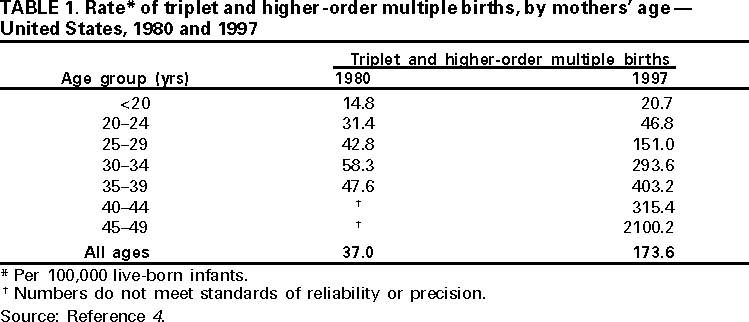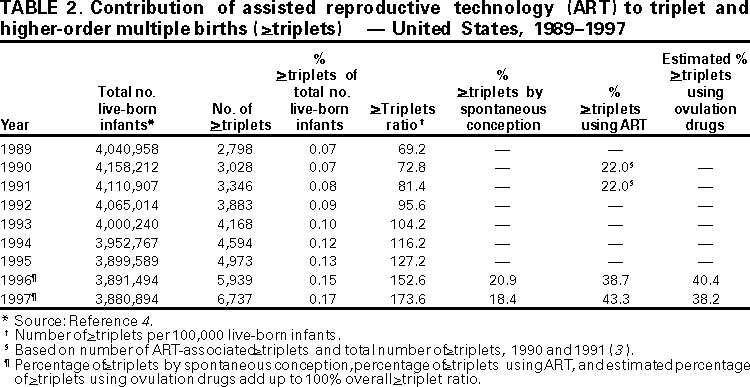 |
|
|
|
|
|
|
| ||||||||||
|
|
|
|
|
|
|
||||
| ||||||||||
|
|
|
|
|
Persons using assistive technology might not be able to fully access information in this file. For assistance, please send e-mail to: mmwrq@cdc.gov. Type 508 Accommodation and the title of the report in the subject line of e-mail. Contribution of Assisted Reproductive Technology and Ovulation-Inducing Drugs to Triplet and Higher-Order Multiple Births --- United States, 1980--1997In the United States, pregnancies associated with assisted reproductive technology (ART) or ovulation-inducing drugs are more likely to result in multiple births than spontaneously conceived pregnancies (1). In addition, triplet and higher-order multiple births are at greater risk than singleton births to be preterm (<37 completed weeks' gestation), low birthweight (LBW) (i.e., <2500 g), or very low birthweight (i.e., <1500 g), resulting in higher infant morbidity and mortality (2). Because preterm and LBW infants often require costly neonatal care and long-term developmental follow-up, the continuing increase in triplet and higher-order multiple births causes concern among health-care providers and policymakers (3). This report provides estimates of the contribution of ART and ovulation-inducing drugs to these birth outcomes for 1996 and 1997, and summarizes trends during 1980--1997, which indicate that the ratio of triplet and higher-order multiple births has more than quadrupled and that a large proportion of this increase can be attributed to ART or the use of ovulation-inducing drugs. CDC's National Center for Health Statistics (NCHS) provided data on live-born infants of triplet and higher-order multiple deliveries (4), and the Society for Assisted Reproductive Technology (SART) reporting system for ART clinics provided the clinical outcomes of ART-associated pregnancies. The 1992 Fertility Clinic Success Rate and Certification Act requires that every U.S. medical center that performs ART report to CDC data for every ART cycle* initiated annually to calculate clinic-specific pregnancy success rates (5). This report uses data from 1996, the first full year CDC collected ART data, and 1997, the latest year of completed data collection. In NCHS and SART, multiple births are counted as individual births rather than sets of triplet and higher-order multiple births. Triplets constituted most triplet and higher-order multiple births: 5298 (89.2%) of 5939 in 1996 and 6148 (91.2%) of 6737 in 1997 (4). ART-related triplet and higher-order multiple births for 1996 and 1997 were expressed as a ratio (i.e., the proportion of ART-related triplet and higher-order multiple births to all live-born infants). The impact of ovulation-inducing drugs not associated with an ART procedure was estimated by subtracting both ART-related births (from the SART reporting system) and spontaneously occurring triplet and higher-order multiple births (6) from the total number of these births. To account for the upward shift in maternal age distribution since 1971 and the increase in spontaneously occurring triplets and higher-order multiple births in women of reproductive age, the ratios for spontaneously occurring outcomes were adjusted for the maternal age distribution of 1997 using the relevant ratios for 1971 (2). This adjustment resulted in a 10% increase in spontaneously occurring triplet and higher-order multiple births from 29 per 100,000 live-born infants in 1971 to 32 per 100,000 live-born infants in 1997. The ratio of triplet and higher-order multiple births for all age groups increased from 29 in 1971 to 37 in 1980; this trend began after the Food and Drug Administration approved two ovulation-inducing drugs, one in 1967 and another in 1970. Following the introduction of ART approximately in 1980, the ratio more than quadrupled to 174 in 1997 (Table 1). Among mothers aged <20 years, the ratio increased from 15 to 21; among mothers aged 35--39 years, the ratio increased from 48 to 403. The contribution of ART to the overall triplet and higher-order multiple birth ratio was estimated to be 38.7% in 1996 and 43.3% in 1997, a substantial increase from the estimated 22% for 1990 and 1991 (Table 2). For both years, approximately 20% were attributable to spontaneously occurring triplets and higher-order multiple births and approximately 40% were attributable to ovulation-inducing drugs without ART. Reported by: Div of Reproductive Health, National Center for Chronic Disease Prevention and Health Promotion; Div of Applied Public Health Training, Epidemiology Program Office; Div of Vital Statistics, National Center for Health Statistics; and an EIS Officer, CDC. Editorial Note:Despite small variations in fertility rates throughout the 1930s--1960s, the ratio for triplet and higher-order multiple births remained stable at approximately 30 per 100,000 live-born infants (6). The reported increase in the ratio of triplet and higher-order multiple births in subsequent decades illustrates the impact of ART and other infertility treatments. The findings in this study are subject to at least three limitations. First, reliable information could not be obtained on the availability and use of ovulation-inducing drugs in the United States. Such information might have been useful in determining the contribution of these drugs to the reported increased ratios and to the increase in triplet and higher-order multiple births affecting all age groups. Second, because ART data were available for only 2 full years (1996 and 1997), trend analysis was not possible. Third, bias might have been introduced using 1971 triplet and higher-order multiple birth ratios for direct age adjustment, which were based on a 50% sample of birth certificate data compared with 100% of data for 1985--1997. Because of the risk factors associated with multifetal births, continued surveillance of pregnancies associated with infertility treatments is important. Although the impact of ART on overall triplet and higher-order multiple births can be estimated using SART data, no reporting system has information on the use of ovulation-inducing drugs not associated with ART. Modifying birth certificate registration to include the type of infertility treatment used to achieve pregnancy would provide such information. Massachusetts has implemented this modification. Given the increased morbidity and mortality associated with multifetal pregnancies, efforts are needed to monitor patients receiving ovulation-inducing drugs and to limit the number of embryos transferred for patients receiving ART (7). These approaches should be preceded by evaluation and specific diagnosis of the infertility status of each patient, and should follow guidelines issued by organizations such as the American Society for Reproductive Medicine and the American College of Obstetricians and Gynecologists (8,9). Strategies to reduce the risk for multifetal gestation have important public health implications that must be integrated with patient needs and concerns, provider practices, and rapidly changing technology. References
* A cycle begins when a woman starts taking ovulation-inducing drugs or starts ovarian monitoring with the intent of having oocytes harvested for in vitro fertilization or other assisted reproductive technique. In most fresh, nondonor cycles, usually one of the following procedures is used: in vitro fertilization involves retrieving a woman's oocytes, fertilizing them in the laboratory, and transferring the resulting embryo(s) into the uterus through the cervix; gamete intra fallopian transfer involves placing unfertilized oocytes and sperm laparoscopically into the woman's fallopian tubes through a small abdominal incision; and zygote intra fallopian transfer involves fertilizing the woman's oocytes in the laboratory and then transferring the resulting zygotes into her fallopian tubes. Table 1  Return to top. Table 2  Return to top. Disclaimer All MMWR HTML versions of articles are electronic conversions from ASCII text into HTML. This conversion may have resulted in character translation or format errors in the HTML version. Users should not rely on this HTML document, but are referred to the electronic PDF version and/or the original MMWR paper copy for the official text, figures, and tables. An original paper copy of this issue can be obtained from the Superintendent of Documents, U.S. Government Printing Office (GPO), Washington, DC 20402-9371; telephone: (202) 512-1800. Contact GPO for current prices. **Questions or messages regarding errors in formatting should be addressed to mmwrq@cdc.gov.Page converted: 6/22/2000 |
|||||||||
This page last reviewed 5/2/01
|